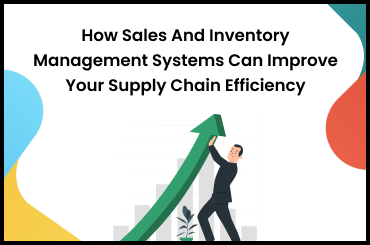In a highly dynamic market like that of India, SME manufacturers find it challenging to maintain profit margins on sales and achieve internal inventory efficiency on the one hand, while growing alongside their competition, on the other hand. This challenge can be solved with a sales and inventory management system. Sales and inventory are two of the most important functions of a business. These functions are also closely interdependent. An efficient sales inventory management is necessary to keep track of inventory items, and upcoming sales and avoid losses. When it comes to sales, a sudden increase or decrease in sales and demand can directly impact the inventory management system. Therefore, efficient sales and inventory software is necessary for small businesses.
In this blog, we'll discuss the importance of inventory management, the key features of a sales and inventory management system, the cost of such a tool and more. Read further to understand in detail about these functions.
What Is Sales and Inventory Management System?
A sales and inventory management system is a tool that can track both sales activities and inventory efficiently using a single tool. A sales order management system offers features such as sales forecasting, and order management. The goal of sales and inventory monitoring system is to digitize sales and stock activities and improve overall business efficiency. Small manufacturers and business owners can leverage the inventory management system to know if their stocks are high or require reordering. At the same time, they can link new sales transactions to plan their inventory levels.
Thereby, sales and inventory software assists businesses to oversee product movements and enables centralized tracking of all related data. It may be a standalone software-based system or part of a broader business enterprise resource planning (ERP) system.
What Is the Objective of a Sales and Inventory Management System?
In a manufacturing company, the objective of a sales and inventory management system is to ensure that sales, inventory and payment functions can be carried out with utmost ease, control and transparency. To understand this better, let's see how a sale occurs in any B2B manufacturing company:
- Customers place an order in exchange for payment.
- The production team processes this order and delivers the product.
- Each payment generates a cash inflow for the business.
- The business generates a corresponding outflow of its product inventory in response to the sale.
The inventory and sales system's main objective is to record each of these sales and inventory movements accurately. A traditional sales inventory management system for small business recorded these transactions in scattered systems, which caused tracking problems.
What makes a software-based sales and inventory management system more efficient is that every transaction entry is auto-recorded and managed in real-time. For example - with a few clicks, businesses can obtain customer order specifications, the production stage where the order is present, order delivery details, and update inventory records simultaneously. This entire process can simplify inventory planning and sales overview, helping organizations to identify problems such as overstocked and under-stocked inventory levels, improving the quality of sales and enhancing the organization's cash flow.
Key Features of Sales and Inventory Management System
Here are key features that an efficient and reliable sales and inventory management system must possess:
1. Automation
A computerized sales and inventory system equips organizations to automate processes that were previously executed manually. Apart from saving time, sales and inventory automation eliminates human errors and frees human resources to focus on other core business operations.
2. Seamless sales and inventory integration
An efficient stock and sales management system must enable seamless integration between the two functions. Sales teams can track real-time inventory levels from any location. At the same time, inventory systems must have real-time access to updated sales orders for timely fulfilment.
3. Information tracking and searching
The inventory and sales management system provides easy and user-friendly search capabilities across sales, purchasing, supplies, and customer queries. The sales inventory system also helps to seamlessly track information related to payments, stock levels, and orders on a live basis.
4. Supplier & purchase information
Sales and inventory software provides easy access to all suppliers' details and inventory purchase information on a single platform. This helps purchase teams save time and manage vendors easily.
5. Customized reports
You can generate customized reports and forecasts related to sales, purchasing, inventory, and payments from an inventory and sales management system. Additionally, in a sales management system software, you can add diverse filters and generate reports based on customers, sales data and more.
6. Data sharing and export functionality
With a sales and inventory management system, you should be able to export stock, product and customer data for improved business convenience. Quick access to customer information, such as contact details, purchase history, insight on best-selling items and other details helps business owners in enhanced decision-making.
7. Order management
Sales inventory software also helps to streamline order placing and fulfillment operations, tracking of orders including purchase orders for suppliers, and updating inventory when orders are ready.
8. Resource management
A sales and inventory system allows you to add, modify, and update records for every item and transaction. This helps to identify which materials are required for production, how they should be allocated and which is the best way to manufacture them.
Benefits of Sales and Inventory Management System
Sales and inventory management is vital for manufacturing organizations as it helps track sales and stocks regularly and eliminates any stock errors that can dampen the production cycle. Let's look at a few benefits of the sales inventory management system:
1. Data security
A stock and sales management system offers end-to-end automation and improves data security while reducing the frequency of security breaches. This system protects data using proven techniques like multi-level data encryption and password restrictions.
2. Improved inventory control
Advanced features such as automated inventory monitoring, barcoding and reporting in inventory and sales tracking systems ensure accurate inventory overview. This ensures that every stock item is properly scanned for quality. Stolen or damaged goods or products are promptly removed from the inventory stock, thus a point of sales and inventory system contributing to improved inventory management and control.
3. Operational visibility
Integrating sales and inventory improves operational visibility into all order processing functions, including accounting, inventory, and order fulfilment. A sales management system system enables cost savings as stocks are replenished using centralized purchasing.
4. Forecasting
A sales inventory software can generate insightful forecasts of product demand, thus ensuring production processes are never hampered due to shortage.
How Much Does a Sales and Inventory Management System Cost?
Various sales and inventory management systems are priced quite differently depending on the features that they offer. Companies would also usually segment their pricing packages based on their multi-tiered solutions starting from base features, going up to advanced features. The cost of inventory and sales management software may start from an estimate of Rs. 4000 monthly and go up to thousands or lakhs for annual plans or lifetime plans. Among the leading inventory management tools, TranZact offers a complete sales and inventory management solution. It enables SME companies to manage not only their sales and inventory operations but also production, reporting, accounting and other functions. TranZact sales and purchase management system offers an option to start for free wherein it allows users to use its base features for free for a lifetime. Users can shift to advanced features only when they're assured that TranZact is the best fit for their business needs.
How to Choose the Best Sales and Inventory Management System?
Every organization has different requirements, which must be considered when choosing the best sales and inventory management system. Here are some considerations:
1. Ease of use
How easy or user-friendly is it for regular users to use the inventory and sales management software? This includes ease of installation, configuration, and understanding of its various features and capabilities.
2. Features
Depending on their business requirements, businesses must create a list of must-have features that should be part of the sales and inventory system.
3. Cross-functional integration
The best sales and inventory management system seamlessly integrates with other core functions such as quotations, purchases and order management. Evaluate the supported integrations available with the software. Additionally, you must also check if it's too complex to integrate the solution into a new tool or system.
4. Customer support
For any solution, active support is vital for long-term benefits. Before signing up for an inventory and sales system, evaluate the types of customer support you have means to, for example, phone assistance, online chats, or email.
TranZact - Best Sales and Inventory Management System in India
Accurate sales or inventory numbers are crucial to maximize your business revenues. To ensure this, it's important that your sales and inventory management teams are able to work collaboratively on a centralized platform. Trusted by over 10,000 Indian SMEs, TranZact solutions are very easy to install, understand and use. They are integrated with quotations, purchases, accounting and production to enhance business efficiency.
It's based on the cloud, which ensures better security, higher scope of automation, reduced costs and higher profitability. It offers a dedicated sales, purchases and inventory module which helps in real-time monitoring of sales and purchases, and accurate inventory valuation. It offers features like barcoding for inventory tracking, auto stock valuation, access to multiple inventory stores, a dedicated transactions module to oversee sales and purchases along with smart business dashboard for insightful reporting.
TranZact also offers lifetime free customer support and seamless integration with popular tools like Tally, Excel, and AfterShip for end-to-end business simplicity. It is the most affordable solution for SME manufacturing businesses with zero upfront costs and effortless implementation when it comes to sales and inventory management.
FAQs on Sales and Inventory Management System
1. How do you keep track of inventory and sales?
You can keep track of your sales activities and inventory levels using an end-to-end sales and inventory management system. Automated inventory and sales management ERP system monitoring is the best way to oversee product movement across workflows as it reduces manual effort. It helps you to keep up-to-date records of inventory and sales, ensuring that you have the right products in stock to meet customer demand, and supporting you to make informed business decisions.
2. What is the relationship between inventory and sales?
Sales and inventory are directly proportional because sales directly impact the company's inventory levels (especially in manufacturing companies). With an increase in sales, inventory stock must rise proportionately. However, inventories must also decrease whenever there is a drop in sales.
3. Which software is recommended for inventory management?
The best software for inventory management must simplify everyday inventory operations such as reordering, multi-store monitoring, order supervision and stock handling. For SME manufacturing businesses, the most recommended software is TranZact as it's user-friendly, cloud-based and also offers a free trial.















